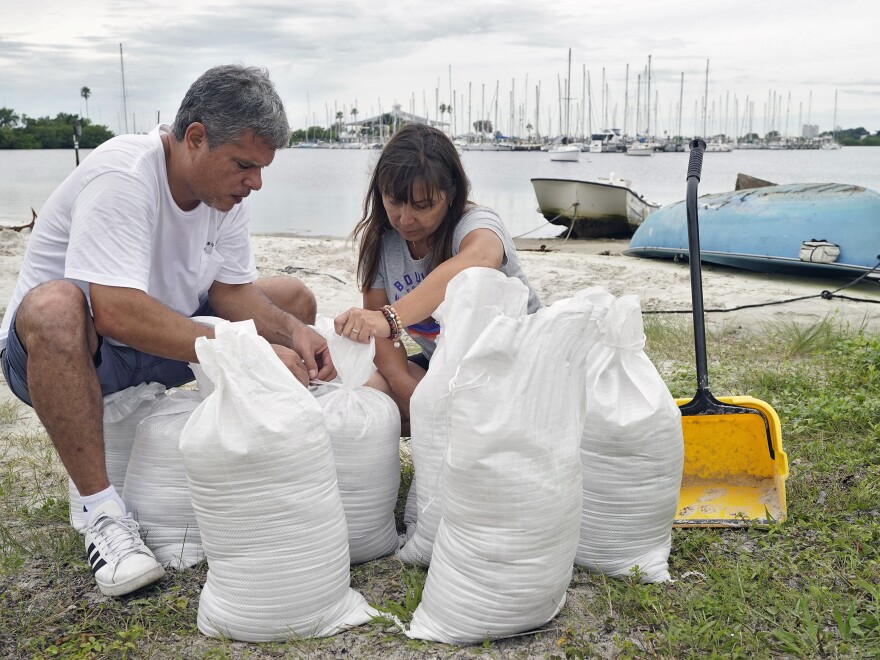Updated September 27, 2022 at 1:38 PM ET
As Hurricane Ian barrels toward Florida, officials there are activating emergency plans and urging residents to evacuate from vulnerable areas.
Ian weakened slightly after passing over Cuba but remains a "major" Category 3 storm, the National Hurricane Center said in a Tuesday morning advisory. It's forecast to reach 130 mph at its peak and hit Florida's west coast on Wednesday, bringing with it heavy rains, inland flooding and life-threatening storm surge.
President Biden has approved an emergency declaration in 24 Florida counties, while Florida Gov. Ron DeSantis has taken steps including mobilizing 5,000 Florida national guard troops. All told, an estimated 2.5 million Floridians are under evacuation orders as of Tuesday morning, according to DeSantis.
Along the Gulf Coast, the cities of Tampa and St. Petersburg are preparing for what could be their first direct hit by a major hurricane since 1921.
"This is ... a storm that we hope would never come to St. Petersburg and Pinellas County, and we've been preparing for this as long as I can remember," St. Petersburg Mayor and lifelong resident Ken Welch told Morning Edition's Rachel Martin on Tuesday morning. "The good news is we do have the data and the science and the surge models that show us where the biggest impacts from the surge will occur."
The city began issuing evacuation orders Monday night, and by Tuesday morning was evacuating three out of the five possible evacuation zones. Officials are opening some two dozen emergency shelters in "high and dry" areas, and first responders and the public transit system have already started helping relocate people to them.

Welch says the priority right now is getting people in vulnerable areas to move to relative safety, which may not be as far away as they think.
"The whole purpose of our mandatory evacuations .... is to move those folks from those coastal areas, the beach areas that are most susceptible to flooding, and moving them to a safe location," he explains. "And it's not a matter of having to move 100 miles. [They] could in many cases move five, 10 miles and be in a safe, high zone right in St. Petersburg or in Pinellas County."
Officials are trying to spread the word about these preparations through press conferences and social media, but Welch says there's only so much the government can do. He's encouraging people to reach out to their friends and family members, especially older residents who may be vulnerable to high water and power outages caused by the storm.
Welch believes there's been a "pretty high degree of compliance" with the evacuation orders, especially from people who have lived in Florida for a long time and seen the impact of other storms that have hit the state.
A similar scene is playing out in Tampa, where mayor Jane Castor told NPR's All Things Considered on Monday night that officials' top concern is evacuating people from the most vulnerable coastal areas.

While she's seen "storm evacuation-notice hesitancy" in the past, she says the severity of storms in recent years — and the historic nature of this one — seem to have more people paying attention. Castor, who served in law enforcement for some three decades, says she's heard unequivocally from people who stayed behind during previous hurricanes that "they would never do that again."
Castor urges people to heed the warnings and leave immediately if they live in an evacuation zone.
"You don't have to go hundreds of miles away. You can just go inland to a relative, to a friend's home," she adds. "We can hide from the wind, but we need to get away from that water in those storm surges."
Of course, there are many reasons why people might be reluctant to pack their bags — from uncertainty about the storm's path to fear of leaving behind pets and personal property, their personal risk calculus and the financial cost of a last-minute evacuation (the Red Cross has a searchable database of shelters here).
To Welch, one part of the problem is a lack of awareness.
"The troubling issue is ... a lot of new people have come to Florida, particularly in the last decade, and we've had a lot of near-misses," he says. "So we're trying to just make folks understand how strong this storm is and how susceptible we are, particularly in St. Petersburg and Pinellas County, to a storm that might just sit off our coast for a while."
This interview was produced by Vince Pearson and edited by Jan Johnson.
Copyright 2023 NPR. To see more, visit https://www.npr.org.







